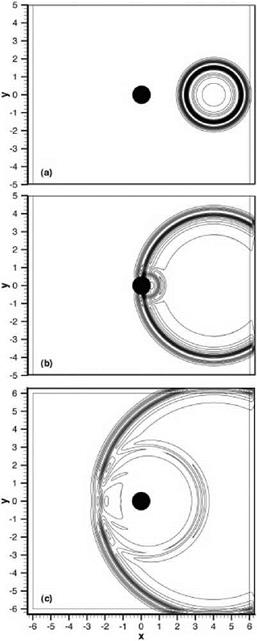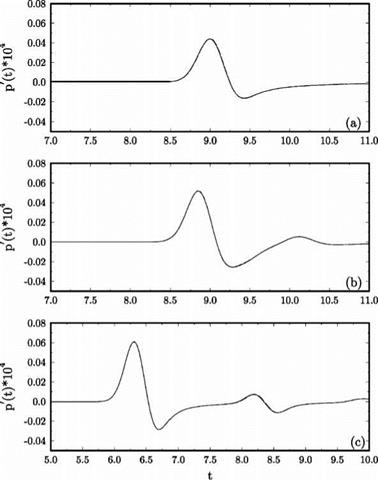Plane Wave Scattering Problem
In a paper by Kurbatskii and Tam (1997), the problem of plane wave scattering by a cylinder was solved using a Cartesian boundary treatment method. Here, the same problem is solved using the overset grids method. One advantage of the overset grids method in this case is that the simple ghost point method may be used to enforce the
Figure 13.15. Pressure contours showing the scattering of an acoustic wave pulse by a circular cylinder. (a) t = 1.6. (b) t = 4.0. (c) t = 6.4. Dashed lines are the exact solution.
 wall boundary condition. Again, the 7-point stencil DRP scheme is used to solve the Euler equations. In order to be able to validate the numerical solution, the amplitude of the incoming waves with wave front perpendicular to the x-axis and wavelength equal to 8 Ax is set to be very small. The problem, therefore, is essentially linear and the accuracy of the computed solution can be ascertained by comparison with the exact linear solution.
wall boundary condition. Again, the 7-point stencil DRP scheme is used to solve the Euler equations. In order to be able to validate the numerical solution, the amplitude of the incoming waves with wave front perpendicular to the x-axis and wavelength equal to 8 Ax is set to be very small. The problem, therefore, is essentially linear and the accuracy of the computed solution can be ascertained by comparison with the exact linear solution.
Figure 13.17 shows the computed zero pressure contours at the beginning of a cycle. Plotted in this figure also are the contours of the exact solution in dashed line. The difference between the computed and the exact solution is very small; less than
|
Figure 13.16. Time history of pressure perturbation p’ = p — (1 /у ) at (a) x = -5, y = 0, (b) x = —4, y = —4, (c) x = 0, y = —5. Dashed line is the exact solution. |
the thickness of the lines. Figure 13.18 shows the computed and the exact scattering cross section а (в) defined by
__ 1
а (в) = lim rp2 2 , (13.42)
where the overbar denotes time average and ps is the pressure of the scattered acoustic waves. There is good agreement between the two. A major part of the small discrepancies arises because the computed result is measured at a finite distance from the center of the cylinder, whereas the exact solution is determined by taking the asymptotic limit r ^ to.














